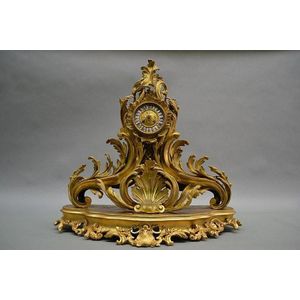Rococo Gilt Bronze Mirror
You must be a subscriber, and be logged in to view price and dealer details.
Subscribe Now to view actual auction price for this item
When you subscribe, you have the option of setting the currency in which to display prices to $Au, $US, $NZ or Stg.
- Foliate - Decorated with leaves or leaf-like forms.
- Bronze - An alloy of copper and tin, traditionally in the proportions of about 9 parts of copper to 1 part of tin.
The discovery of bronze in Western Asia in the 4th century enabled people to create metal objects which were superior to those previoulsy possible because of its strength and hardness, and it has been used throughout the world for weapons, coins, tools, statuary and other decorative items.
It is very fluid in a molten state, and its hardness, strength when set, and non-corrosive properties makes it most suitable for casting sculpture. - Rococo - A stylistic development covering the period from about 1730 to 1770, during the reign of Louis XV in France. The rococo style falls between the rather overbearing manner of the Baroque and the formal elegance of Neoclassicism. The Rococo style reached its full maturity in France, though many of its features were used by English furniture makers. The style is marked by asymmetrical forms, especially pierced and intricate scroll work as in mirror frames, chair backs etc., and the use of shells and floral motifs. The term derives from the French 'rocaille', meaning rock work, as in gardens and fountains. There was a major Rococo revival in the mid-19th century and indeed much of what is now considered to be typically Victorian furniture is influenced by the Rococo. It is essentially feminine in feeling, and for this reason, perhaps, was regarded as rather frivolous by its successors.
- Pediment - The uppermost section of a tall usually double-heightened piece of cabinet furniture, surmounting the cornice. The pediment can take a variety of forms derived from the architecture of classical antiquity. A broken pediment is of triangular shape, however, the two raised sides do not meet at the apex but are 'broken' the gap between them often ornamented with an urn or finial. Swan-neck pediments are of similar form, although the uprights are gracefully arched, resembling a swan's neck. They are often found, for example, on longcase clocks.
- Circa - A Latin term meaning 'about', often used in the antique trade to give an approximate date for the piece, usually considered to be five years on either side of the circa year. Thus, circa 1900 means the piece was made about 1900, probably between 1895 and 1905. The expression is sometimes abbreviated to c.1900.
This item has been included into following indexes:
- mirrors, wall, material - iron, brass bronze and other metal 164
-
mirrors, wall, period, age or style
- French 663
- Louis style 371
Visually similar items

Impressive & large antique mid 19th century French gilt bronze clock in the rococo form, standing on a ornate gilt wood base

A sterling silver and rose gold shield pendant engraved Buttle's dancing Competitions 1929 Xmas

A fine Kassa Mala Kingdom gilt-bronze figure of Green Tara (Syamatara), circa 14th century, Seated in lalitasana on a double-lotus throne, a lotus branch at each shoulder, encrusted with semi-precious stones, the back of the throne painted ref (typical of

A large ormolu rococo style mantle clock, circa 1900, with maker's mark for Marti et Cie, an extravagantly cast waisted case with acanthus and shell scrolls surmounted by a crest with a leafy flourish and a vegetal finial, the dial with a cream enamel chap
